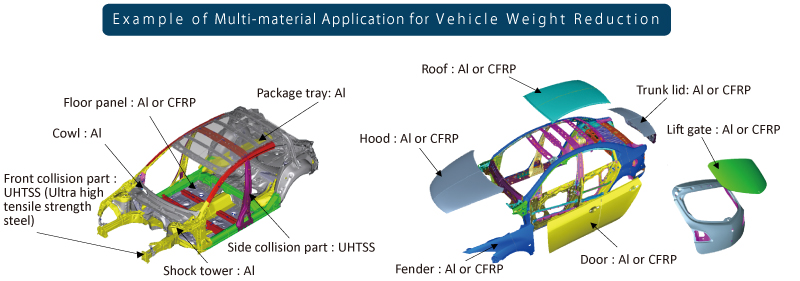Project Overview
ISMA is responsible for the NEDO commissioned project “New Innovative Structural Materials Research and Development,” in which we promote higher performance in main structural materials and the development of multi-material technologies in an integrated manner with the aim of realizing radical weight reduction (one-half of current weight) in transportation equipment, particularly in automobiles. The aims of this project are to reduce energy consumption and CO2 emissions by improving the fuel efficiency of transportation equipment, accelerate the popularization of next-generation automobiles, and strengthen the international competitiveness of Japan’s parts/materials industries and the automobile industry and other industries that use those parts and materials.

About the “Innovative Structural Materials R&D Project”
“Innovative Structural Materials R&D” is a project being carried out by ISMA under commission from Japan’s New Energy and Industrial Technology Development Organization (NEDO).
To NEDO website (in Japanese)
Research Approaches
The themes of the first half of the project (FY2013-2017) were improvement of performance that satisfies both strength and ductility for metal materials, examination of applicability to body/structural parts for CFRTP (carbon fiber reinforced thermoplastics) and the development of technologies utilizing fusion welding and friction welding for welding and joining technology. Based on the research results of the first half, the themes for the second half (FY2018-2020) are solution of problems related to the production of parts and technologies for realizing multi-material structures, study of modeling of the automobile body-in-white and R&D aiming at practical application and commercialization.

Until recently, development of technologies for auto weight reduction had focused on shape optimization as an extension of the conventional technology. However, multi-material design has become increasingly important in recent years. “Multi-material design” means selecting the optimum lightweight material, such as high strength steel, aluminum or CFRP, and applying that material to the optimum part. Although multi-material design has already been applied to some luxury automobiles and sports cars, the aim of ISMA is to apply this concept to mass production cars by utilizing Japan’s unique technological capabilities.

Nevertheless, various issues must be overcome for weight reduction of structural materials. For example, in the case of metal materials, if strength is increased to enable weight reduction, ductility (elongation) decreases. Conversely, if ductility is improved to secure good formability, strength decreases. This phenomenon, known as the “banana curve,” is illustrated in the figure at the left. In research at ISMA, our target is to develop materials and technologies which enable simultaneous improvement of these mutually-contradictory properties. Moreover, in addition to strength and ductility, it is also necessary to consider specific stiffness and specific strength in development for weight reduction. (See the figure at the right; these properties are defined as stiffness and strength divided by density.)


Framework for Research and Development
Research Centers in Charge (Satellites)
Members of ISMA (with some exceptions) carry out activities centering on R&D as research centers in charge (satellites) of the ISMA Project.
Akashi (Kawasaki Heavy Industries), Chiba (JFE Steel), Chigasaki (Toho Titanium), Chitose (UACJ), Fukaya (UACJ), Chofu (Mechanical Design), Futtu (Nippon Steel) , Amagasaki (Nippon Steel), Hachioji (Konica Minolta), Hamamatsu-ACT (Armonicos) , Handai-setsugouken (Osaka Univ.), Handai-kougakukenkyuka (Osaka Univ.) , Hiratsuka (Nihon Parkerizing), Hiroshima (Mazda Motor), Hitachi-Omika (Hitachi), Hitachi-Ouse (Hitachi Power Solutions), Hitachi-yasuki 1(Hitachi Metals), Hitachi-yasuki 2(Hitachi Metals Precision), Imizu (Sankyo Tateyama), Itabashi (Nippon Kinzoku), Iyo(Toray Industries), Koga (Cemedine), Komaki (Dai Nippon Toryo), Kyoto (Shimadzu) , Mishima (Teijin), Nagasu (Fuji Light Metal), Nagoya Univ. Central Intensive Labo (Nagoya Univ.), Nagoya-Atsuta (JFCC), Nagoyo-Moriyama (AIST), Tsukuba-Cyuo-Umezono (AIST), Tsukuba-Cyuo-Higashi (AIST), Tsukuba-Onogawa (AIST), Natsushima (Nissan ARC), Seishin (Kobe Steel), Shonan (TCD), Takaoka (Takagi Seiko), Toki (Takasago Industry), Tsukuba-Sengen (NIMS), Yokohama-isogo (IHI), Yokohama-kanazawa (J-TREC) (Alphabetical order; as of April 1, 2021)
Research Subcontractors
ISMA promotes research and development through collaboration in a form in which ISMA member organizations, which are shared R&D centers (satellites), subcontract some research to universities, research institutes and others.
Akita University, Gifu University, Gunma University, Hiroshima University, Hirotec Corporation, Hokkaido University, Ibaraki University, Industrial Technology Innovation Center of Ibaraki Prefecture, Iwate University, JAEA, Kanazawa Institute of Technology, KEK, Kindai University, Kobe University, Kyoto University, Kyushu University, Million Chemicals Co., Ltd., Nagaoka University of Technology, Nagase ChemteX Corporation, Nagoya Institute of Technology, National Maritime Research Institute, Nihon University, Osaka Institute of Technology, Osaka Prefecture University, QST, RIKEN, Shimane University, TDS Co., Ltd., Teikyo University, The Japan Magnesium Association, The University of Tokyo, The Yokohama Rubber Co., Ltd., Tohoku University, Tokyo University of Technology, Toyohashi University of Technology, University of Hyogo, Waseda University, Yamagata University (Alphabetical order; as of April 1, 2021)
Framework for Cooperation
ISMA promotes research and development in cooperation with the “Cross-ministerial Strategic Innovation Promotion Program (SIP): Innovative Structural Materials” of the Cabinet Office, Government of Japan and the “Element Strategy Initiative: To Form Core Research Centers” of the Ministry of Education, Culture, Sports, Science and Technology (MEXT).


